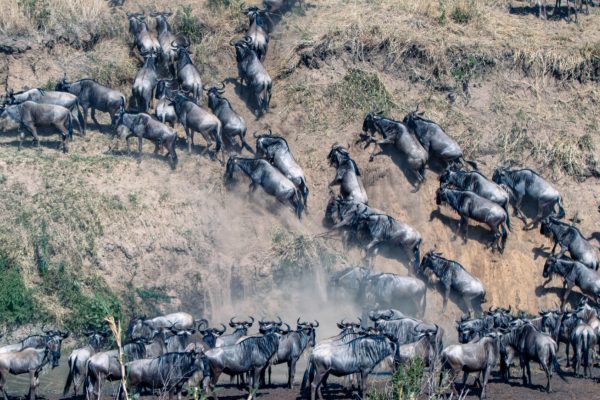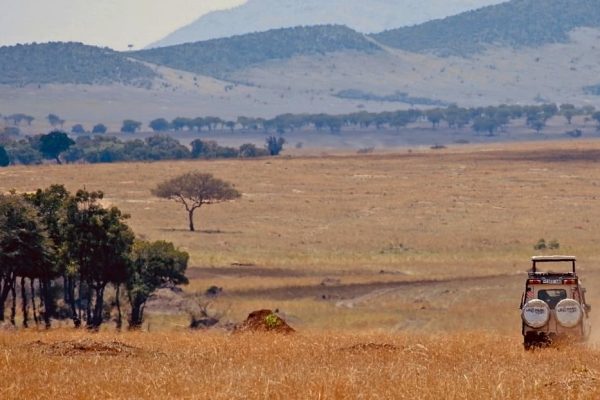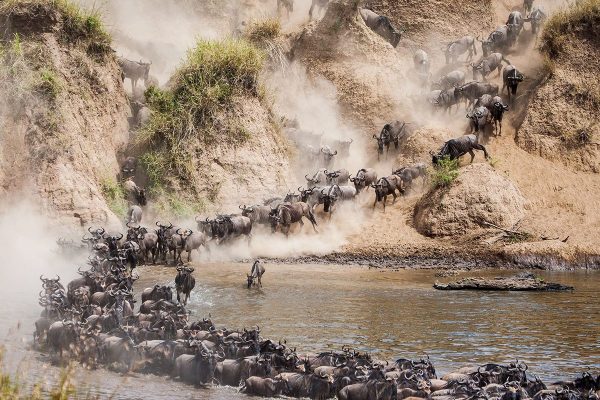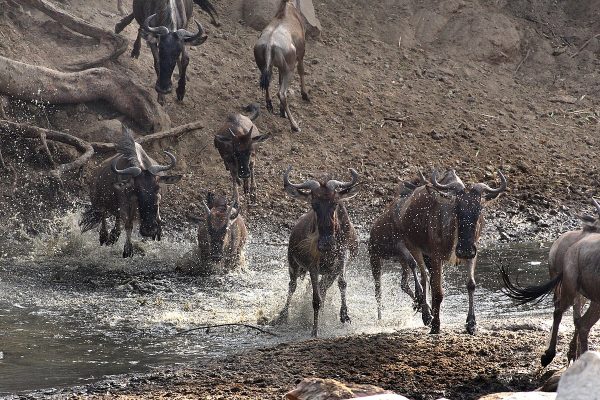The Great Wildebeest Migration Tracker, Map & Facts
The Great Wildebeest Migration is a yearly phenomenon in which millions of wildebeest, accompanied by zebras and other savannah fauna, traverse the Serengeti and Maasai Mara in pursuit of verdant pastures and precipitation. The migration coincides with the rainy season, often occurring from July to November, with the peak period in July and August.
Along with the Gnu Migration, Serengeti Migration, and Masai Mara Migration, the Great Wildebeest Migration in Africa is among the world’s last remaining large migrations of terrestrial animals. It is the main attraction that draws a large number of tourists to Kenya and Tanzania for migration safaris, particularly during the middle of the year.
Time is of the essence during the Migration, but the animals’ movements cannot be predicted, creating one of the biggest contradictions in nature. Everyone is aware that the wildebeest, along with a few zebras and antelope, will ford the Mara River at some point, but no one knows when precisely. We also know that wildebeests will start migrating to new pastures when it rains, but no one can predict when it will rain with any degree of certainty.
Luckily, our Wildebeest Migration safaris in Africa have been in the works since 2021. We’ve assisted countless vacationers in getting where they need to go as efficiently and affordably as feasible. There is no need to search any farther for professional planning help. In this comprehensive guide for first-timers to the Wildebeest Migration, we’ve included all of our expert knowledge and advice.
Best Wildebeest Migration Safari Tours
To help you get a feel for the price, flights, and interconnections between locations, we have provided some sample itineraries as tour options. You may tailor each one to fit your own needs in terms of time, money, and taste.
Kenya And Tanzania Migration Safari
For the greatest chances of seeing the Great Migration and possible river crossings, it is typically recommended to combine a trip to Tanzania’s Serengeti with a visit to Kenya’s Masai Mara between July and October.
In search of new forage, the herds often make multiple crossings of the Mara River at various intervals throughout the year. This Kenya And Tanzania Wildebeest Migration tour incorporates a little amount of driving in the Serengeti and a descent of Ngorongoro Crater to keep the price range affordable.
We can tailor your Kenya And Tanzania Wildebeest Migration safari itinerary to your interests, so if you have extra time, you may extend your stay to include Tarangire and Lake Manyara.
Masai Mara And Serengeti Migration Safari
Adding the Ngorongoro Crater to a safari that already includes Tanzania’s Serengeti and Kenya’s Masai Mara guarantees one of the most wildlife-intense experiences in Africa. Game drives, hikes, and horseback safaris accompanied by knowledgeable guides will allow you to see the Big 5, large herds of migrating wildebeest, and the predators that prey on them. The abundance of wildlife on this trip ensures that you will have excellent game watching at every stop, regardless of whether you go during migration season or not.
Beginning with the rustic elegance of a Tanzanian coffee farm and a magnificent manor home situated on the rim of the Ngorongoro Crater, this 10-day journey is a typical fly-in safari that includes exceptional lodging. Tented safari camps in the Masai Mara and the Serengeti provide a relaxing retreat after a long day of exploring, and they’re all strategically placed to witness the Wildebeest Migration in all its glory. These lodgings also have a massage service, babysitters, private dining, Wi-Fi, pools, and other nice additions that guests will appreciate.
Masai Mara River Crossing
The Great Migration is a yearly cyclical event in which plains game, including wildebeest, follow the rains from the Serengeti’s eastern edge westward through Ngorongoro Conservation Area’s northwest, then north to the Masai Mara, and finally eastward through the Serengeti’s central and western regions.
Throughout the entire Great Migration, there is a lot to see and do: the herd continues to move south in November and December, after calving in January to March, rutting in April and May, river crossing in June to October, and the herd starts moving north again in January to start the whole cycle over again. The river crossings are considered by most travelers to be the most thrilling and an absolute must-do for anyone hoping to witness the Great Migration.
Grumeti River Migration Crossing Safari
Nature enthusiasts must witness The Great Migration as it crosses the Grumeti River near the Kirawira section of the Western Corridor; however, those with weakened stomachs should probably pass. The crocodiles in this area of the river are famously plentiful; they wait impatiently for the migratory herd to cross so they can have a guaranteed meaty feast. In spite of the clear peril, the zebras and wildebeests would not budge from their relentless pursuit of their ultimate goal. Elephants, hippos, and monkeys are among the other creatures that inhabit the river and its waters.
Come between July and November if you want to witness the Great Migration from this Serengeti location. Bring a boxed lunch to eat picnic-style by the river, according to recent visitors.
How Does The Great Migration Work
Can The Migration River Crossings Be Predicted:
No one, not even the wildebeest, can predict when the crossing will occur! There are some that get to the water and swim over right away, some that spend days grazing, and still others that go back the way they came. No one can foresee the crossings, no matter how much we try. Because of this, if you want to view a river crossing while on safari, you need allow yourself plenty of time.
What Month Is The Wildebeest Migration:
Despite popular belief, the Wildebeest Migration is a year-round phenomenon that takes place in a cyclical pattern and isn’t limited to the months of July to October. Many people believe that the wildebeest migration or sightings are limited to the months of June through October since major river crossings occur during this time of year.
Where Does The Great Migration Start:
There are no set beginning or ending locations to the Great Migration because the movement of over two million animals through the Serengeti-Mara habitat is dynamic and occurs throughout the year. The Gnu Migration begins when it rains in East Africa, and the animals travel along a long-established path to find new pastures and water. The great migration begins in Kenya’s Masai Mara plains and continues south into Tanzania’s Serengeti and the edge of the Ngorongoro Crater. Then, the animals make a clockwise loop back to the beginning.
Why Do Wildebeest Migrate:
Most people think that the weather has a major role in determining the Great Migration in Africa. Following the rains and the sprouting of new grass, they migrate in what is essentially a survival instinct to locate food. Although there is no hard evidence, some scientists think that distant lightning and thunderstorms stimulate the migration of the wildebeest.
Best Time To Go On A Wildebeest Migration Safari:
With this newfound knowledge of the Great Wildebeest Migration in Africa, it’s easy to understand that the ideal time to visit is totally dependent on your own interests in witnessing the many activities. You may go on a safari in the Serengeti or the Masai Mara at any time of year because of the diverse species and expansive terrain.
| Event | Approximate Time | Place |
| Calving (Birthing) Season | February to March | Southern Serengeti |
| Rutting (Breeding) Season | April to May | Western & Central Serengeti |
| Grumeti River Crossings | May to June | Central Serengeti |
| Mara River Crossings | July to August | Northern Serengeti & Masai Mara |
| On the Move | November to January | Masai Mara & Northern Serengeti to Southern Serengeti |
Note:
Note that the dates provided are simply estimates. Due to the unpredictable nature of the river crossings, the Wildebeest Migration is a cyclical process that occurs every year. The herds may travel four times in a single day, or they may remain still for two weeks.
Key Facts To Remember
- The Serengeti is where most of the Migration happens.
- The journey repeats itself throughout the year.
- It is impossible to forecast when a river will cross, however it is usually between May and August.
- Over a vast expanse, the animals are dispersed; inevitably, there will be those that go ahead and some that fall behind.
- If you want to watch river crossings, you might want to spend the day in a spot where the wildebeest have gathered.
- Be ready for the sun and glare to be at their worst about noon if you’re a serious photographer; that’s when you might get the greatest shots.
Great Wildebeest Migration
Greatest Migration from Tanzania to Kenya
The Great Migration Masai Mara Kenya
Tips For Planning Your Wildebeest Migration Safari
Book Early – At Least a Year in Advance:
Between June and October, when the Great Migration is in full swing, lodges and campgrounds tend to fill up quickly. You can observe the herds at any time of year, but keep in mind that this is the peak season for safaris and the time when the famous river crossings take place.
Arrange Your Timing Carefully:
In many ways, the outcome of the Migration is completely up in the air. To get the most out of your Wildebeest Migration safari, it’s crucial to plan ahead of time and know when to go. Pick and choose when you want to do things based on your interests.
Avoid the Crowds:
From June through October, when safari season is in full swing, the Masai Mara and Serengeti National Parks see an influx of tourists and vehicles. Exquisite wildlife watching in sole-use areas, private conservancies that border the Masai Mara, and opulent lodging are all on the menu. Night drives, bush hikes, and off-road wildlife watching are some of the other activities that will be available to you that are not allowed in the main reserve.
Camping in the Serengeti allows you to be close to the activity during the migration, but far enough away to enjoy some peace and quiet if you so desire.
Diversify Your Game Viewing:
A wildebeest migration safari is very different from a typical Big Five safari due of the increased activity, noise, and odor. To end your safari on a more quiet note and see more game, we suggest ending at a camp or lodge far from the herds.
Augment Your Migration Safari:
You can build a safari around the Masai Mara and the Serengeti, or you can visit both together. Consider merging the Masai Mara with Amboseli and Laikipia, or expanding the Serengeti to include Tarangire, Ngorongoro Crater, and the Rift Valley Lakes. Expanding your horizons even further, you may effortlessly include popular locations such as:
- The greatest places to go gorilla trekking in the world are in the Congo, Rwanda, or Uganda.
- If you’re looking for a place with beautiful tropical beaches and great diving, consider Zanzibar, Mauritius, or the Seychelles.
- Visit Cape Town for world-class dining, world-class wine, world-class shopping, stunning beaches, rich culture, and breathtaking scenery.
- Experience white-water rafting at the world’s largest waterfall, Devil’s Pool swimming, and tea on Livingstone Island.




